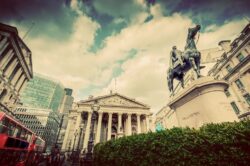The US dollar is rising thanks to a jump in US bond yields since August. That bodes ill for global trade.
But what else does it bode ill for? And how did the US dollar become so important in the first place?
The history is fascinating. To me, anyway…
The world has often had what’s known as a global reserve currency. The name is a bit misleading, although the US dollar is also a popular way for countries to keep their reserves.
A reserve currency is the “global money”. It can be used anywhere and is thus used everywhere that money crosses borders. It’s much easier that way. If you know everyone will accept dollars, there is no disruption or complication from everyone using dollars at the outset. Until the US dollar’s value suddenly changes, that is…
But back to the history for now.
Usually, gold functioned as a global reserve currency. But gold can be a challenge to move around. And so countries and large companies used currencies backed by gold, and redeemable too. That gave them gold’s stability and national currency’s convenience.
Before the world wars, Britain’s pound served as a global reserve currency. Before that, the list is a long one, featuring the Dutch and the Spanish currencies.
It seems a navy has something to do with whose currency serves as the global reserve. Perhaps because international trade is largely on the seas.
Anyway, after World War II, the US had its mighty economy intact and its mighty navy puttering around just about everywhere. And so, when the time came to figure out how global trade would be conducted in the post-war economy, they had the upper hand.
At the Bretton Woods conference, Britain’s John Maynard Keynes argued that a new global currency should be used to conduct trade. And it should be backed by gold. He wanted to call it the bancor. But the Americans got their way and the US dollar became the centre of the financial universe instead.
This had a lot of different effects. Most are curses disguised as blessings.
You see, nations wishing to trade must first get their hands on US dollars under the Bretton Woods system, as it became known. That means selling something on the international markets.
But the Americans? They could just print the money and buy stuff…
While the French were busy telling the world that this was an “exorbitant privilege”, the Americans got busy proving them wrong. In fact, it was Nigel’s old friend Valéry Marie René Georges Giscard d’Estaing who coined the phrase “exorbitant privilege” to describe the Americans’ situation. Even though it proved to be anything but.
Under the Bretton Woods system, the US printed and spent so much money that it didn’t have enough gold to make good on all those dollars. And so, when the French had de Gaulle to demand their dollars be redeemed for gold, they ended up triggering the Nixon Shock instead. That ended the convertibility of the US dollar to gold in 1971. Global money was no longer backed by anything.
Then we had the inflation you’d expect from worthless money. Something that was spread around the world by the US’s dollar thanks to its reserve currency status.
The 90s gave us a crisis which I want to draw your attention to today given the recent moves in the US dollar and interest rates.
You see, the US’s central bank doesn’t set monetary policy for the benefit of global trade. It sets the right rate for the US economy. Domestic conditions.
But what happens to everyone else who uses US dollars then? They occasionally fall on their faces. Well, they’re tripped up by rising American interest rates.
That’s what happened in the Asian Financial Crisis of 1997. Nations in Asia had pegged their currencies to the US dollar, meaning the exchange rate didn’t move. They had also borrowed huge amounts of US dollars in debt, as had the companies booming inside them.
But when interest rates in the US doubled in the mid-90s, things got dicey. Borrowers faced higher costs and nations had to use up their US dollars in the foreign exchange markets to keep their peg in place.
They failed. George Soros made money and headlines for all the same reasons once again, only it was Asian countries instead of Britain in his sights this time. And a global financial crisis began.
It was an important lesson. That the world didn’t seem to learn:
(Reuters) – Global foreign currency debt – where the rest of world borrows in dollars, euros or Japanese yen – has hit a record high of over $16 trillion, data from the Bank for International Settlements showed on Thursday.
That’s a lot of debt denominated in currencies which central bankers will set interest rates for. But they won’t be focusing on the borrowers’ welfare, they’ll be focusing on their domestic economies.
As you know from yesterday, US rates have doubled since August. The US dollar is still the global reserve currency. And its interest rates still threaten to cause trouble. The Bank for International Settlements: “US dollar credit to non-bank borrowers outside the United States grew by 6% in 2019, to reach $12.2 trillion at end-2019.”
It’s not just interest rates. It’s also exchange rates.
What made the Asian Financial Crisis so dramatic was that companies borrowed money thinking the value of the exchange rate wouldn’t change. The peg would hold. But it didn’t. And that made the debt even more unaffordable.
There is a risk of repeat. The world is drowning in debt thanks to Covid-19. If interest rates or the US dollar spike, there will be a crash as debt becomes unaffordable.
I suspect that’s one reason our investment director Rob Marstrand is being very conservative over at UK Independent Wealth. Like Nigel, he’s suspicious about just how optimistic investors and the media are getting.
Perhaps the rising US dollar will prove their strategy correct.

Nick Hubble
Editor, Fortune & Freedom




